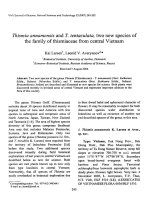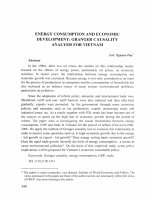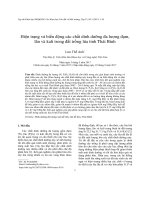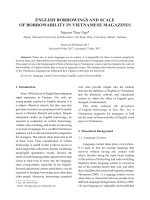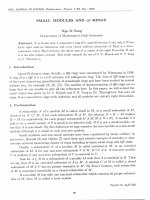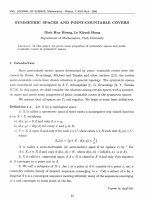DSpace at VNU: Mesh-independence principle and cauchy problem for differential algebraic equations
Bạn đang xem bản rút gọn của tài liệu. Xem và tải ngay bản đầy đủ của tài liệu tại đây (2.1 MB, 7 trang )
V N U . J O U R N A L O F S C I E N C E , M athem atics - Physics.
T.xx,
N()4 - 2004
M E S H -IN D E P E N D E N C E P R IN C IP L E A N D C A U C H Y
P R O B L E M F O R D IF F E R E N T IA L A L G E B R A IC E Q U A T IO N S
N g u y en M in h K h o a
Hanoi Universtity o f Transport and Communications, Hanoi, Vietnam
A b s t r a c t . In this paper, we apply the m esh-independence principle to differential alge
braic equations.
1.
In tro d u c tio n
It was shown by the mesh-independence principle th at if the Newton’s method is used
to analyse a nonlinear equation between some Banach spaces and some finite-dimensional
discretization of th a t equation then the discretized process is asymptotically the same as
that for the original iteration. As the result, the number of iterations steps needed for
two processes to converge within a given tolerance is basically the same [1 ]. Consider the
following equation:
( 1 .1 )
F{z) = 0
where, F is a lionlienar operator between Banach spaces A , Â . The Newton’s method is
defined as follow:
Zn+1 =
zn -
[ _F' (z n ) ] - 1 F ( z n ),
n = 0, 1 , 2 , . . .
(1.2)
Under certain conditions, equation ( 1 .2 ) yields a sequence converging quadra.tica.lly to a
solution z* of equation ( 1 . 1 ). Normally, the formal procedure defined by equation ( 1 .2 ) is
not suitable ill infinite-dimensional spaces. Thus, in practice equation (1.1) is replaced by
a family of discretized equations:
$ h (O = 0
(1.3)
where h is some real number and $/, is a nonlinear operator between finite-dimensional
spaces Ah, Ah- It we define Ah to be the bounded linear operator A h : A —> Ah, then
equation (1.3), under some appropriate assumprions, have solutions
which are the limit
of the Newton sequence applied to equation (1.3). These solutions are obtained as follows:
+ 0(h?)
c =
and are started at A hZ0 t h a t is:
t i = A hz 0 Cn+1
n = 0 ,1 ,2 ,...
(1.4)
T y p e se t by ^4Ạ/f*S-TgX
18
19
M e s h - I n d e p e n d e n c e P r i n c i p l e a n d C a u c h y P r o b le m f o r .
Observations in many computations indicates th a t for a sufficiently small h there is at most
a difference of 1 between the num ber of steps needed for the two processes of equations
(1.2) and (1.4) to converge within a given tolerance £ > 0. T h a t is one aspect of the meshindependence principle of Newton’s method. Another aspect is th a t, if discretization
satisfied certain conditions then:
Ù -C n =
- z*) + 0 { h * )
c + l - ( n = A f c ( Z n + 1 - z n) + ° ^ v)
$>h{ í nh ) = ằ hF { z n) + 0 { h V )
Í 1 -5 )
The aim of this paper is to apply the m e s h - independence principle to differential alge
braic equations. The paper consists of two sections dicussing the N ew ton’smethod for
continuous problems and the N ew ton’s method for discretized problems.
2. T h e m e s h - in d e p e n d e c e p r i n c i p le
2.1. N e w t o n m e t h o d f o r c o n t i n u o u s p r o b le m s
( x' (t) =
y( x( t ) , y( t ) )
y(t)=
2/( 0) =
/(x(t).y(O )
yo-,x( 0) = x o
yo —
f ( x 0,yo)
( 2 .1)
t € [0, T] = }
X €
W" \ y
€
R n~m,g : Kr -> Rm, / : R'
R'
Without, loss of generally, we may assume th a t yo = 6\x 0 — 0.
The norm in R s spaces on MpX
w h ere p , q , s £ N V x £
cụ, ss) : | | x | | o o
=
m a x , \x{t)\
z := {z = ( x , y ) e C ( J , R n) : I e C 1 ( J , n
IN I : = IM loo + M o o
w := C{J, Mn)
Hypot hes es
Hi) (1.1) has a solution z* = (x* , y *) e z such th at
G := ( g , f ) T £ C l (U(z*, p))
where
x ( 0) = ỡ, y( 0) = Ớ}
20
N g u y e n M in h Khoa
ư := ư ự , p ) = { ( x , y ) € K" : 3í e J : \x - x*{t)\ < p, \y - y*(t)\ ^ p )
dg
Ho)
ỗ < 1.
d£
00, X
dx (*)
i (2)
Ox (*)
£ := B ( z \ p ) = { z e z : \\z - 2*11 ^ p}
\/z e B, Vh = (hl ì h2)T e z ,
X - g(x,y)
y - f (x, y)
F(z) :=
F : z —> W\ th at is
'h' - Ẽ l h ' - Ẽ i ĩ
F'(z).h — h[ - i ' * 1 ■ Ị ' * 2
- 1
*> -
«.
The Newton’s method for problem ( 1 . 1 ):
Zk+I = Zk - [ i?/(z /ỉ) ] “ 1. F ( z ít), w it h / ỉ (fe) : = (/ỉ,ịfc), / 4 fc)) r
w
h' ’ -
Vk)
a-’ic -
^ 2° “
tJt ■ h ' “
Vk - f ( x k, yk)
' !/i )/'-i
( 2 .2 )
By the Gronwall’s inequality and OI1 the hypotheses: Let g j has continuos Lipschits 011
the open domain u the g
g
g
by z we have the following attraction theorem for
Newton’s method described by ( 2 .2 )
T h e o r e m 2 . 1 . Suppose that (Hị ), ( H2) are fulfilled. Then
1) Vz € z?,3 [ F '( z ) ] - 1 and ||[ F '( ^ ) ] - 1|| s' c
2) V z , i e D : ||F ;(z) - F'(ã) II < / | | z - i | |
3) For Vz0 € £* := B[z*,r*],r* =
3C /
The Newton’s method converges to z* : (x y*)
2.2 N e w to n m e th o d f o r d isc re tize d p r o b le m s
With
T
h
:=
Zfc =
/, =
N Gh
{c =
:=
=
__ _
th’1 = ° >
(Co, • . . , c n
m ax I & I +
qÌ i% n '
) ■Co
m ax
OS^JV-I
= 0,
Ởh =
Ci =
— —
h
G 'A { 0 ,T }
( 6 , r/i),
=
t,
€
mmaaxx If;I
|£J +-f
0™ | i v Ki|
N
IỈ h = { n = (7 /0 ,... , r i N - i ) , V i e /?'* (t = 0 J V ) } ;
7/, e
/Ỉ" -'"
I n iax
00<
llr/llft =
max
0
Si
(i = O JV )}
M e s h - I n d e p e n d e n c e P r i n c i p l e a n d C a u c h y P r o b le m f o r .. .
21
When the (leseretization of (2.1)
£k + l — £a- +
2 (gk.+ \
+ fjk)
fc = 0, TV — 1, £o = 0, 7/0 — 0
£fc+i - £k - y( 9k + 1 + ỡfc) = 0
'f/fc+i—fc+1 — 0
Ẵ: — 0,7V — 1
£ = 0, 7, = 0
/I
^ yv" 1
£fc + l - Ca: - 2 (ỡ*+l + 9k)
Co = 0,770 = 0
VC G z ,, : $ f c ( 0 : =
f (£>k+l 1 ^/A:+ l )
Vk+l
J/c= 0
We have discretized equations
(2.3)
* '/,(0 = 0
We obtain
Ỉ _ I
_ I
h
2 <9£ ’ 2
ỠÍ ’
K (0 -
4
dr] 1
1
’"
0
0
ỠTỊ ’
Cl
C'2
...
ÌÔPTV-I
1
2 0£ ’ //.2 ỠÉ ’
f N 1 -----i
Ỡĩi N
_Ỡ
_±11
l
’ h
0
ÔC
uVi ),
when c,: = (&,'/<), ^ j | =
1
1 dgN
X
2 dĩ)
rN
ỡry
= -Jị{íuV i)- We have Newton’s method
r o + i(A0 = C M + /iỉì(*o
fc = l , 7 V ,n = 0 , 1 , 2 , .
l & ti{k).ti(k) = - * n M k ) )
The Newton discretized sequence
C,';+1 =
c - [KiO] -"1 -MC'D, n = 0,1,2,...
The discretization m ethod to be considered here will be described by a family of triplets
{$/!,!!h, r}. The first, we consider [ $ / , ( 0 ]
Co
— Of 4-
01
1 - 5
and
\ with
A:
27
1
- Ỗ
x
a
27
< A < —+
Ị3
ỉ - Ỏ
and
c :c
We consider
> max
A(1 - S) - 2 7 ’ A(1 - S) - 7 e2C°T
22
N g u y en M in h Khoa
|IK (C )]“ I N c*,
c * = m ax { C .e2 C r, AC}
Put
z0 ':=
{z e
I^loo ^
{Bo,
z : X e c2ụ , Rm),
ll^lloo ^
Bị ,
y e C \ J , / ? " - ”')}
llýll íC
B2 }■
When: Vz £ Zn we have
i ( i i ) —</(ar(íi), Ỉ/(Í1>)
y ( h ) - /(* ơ i),y (fi))
rF (z)
à ( t N ) - g ( x ( t N ) , y ( t N ))
y ( t N ) - f ( x N , Un )
H/i z (^11 -2-27• ■- )) ĩ 2i •— £ (£j)
— /t — - ^ ỉỡ (® i,ĩ/i) + ớ(zo,yo)]
2/1 $ h [iM
=
ZN — X N - l
1
[ 9( x n , v n ) +
2 L
Ĩ/N — / ( % , :ợaO
Using finite incrrnent formular we find th at
||r ( F ( z ) ) - ^ ( r U z ) ! ! ^ Cỏ /í,, Co :=
Bn +
a D 1 + /3Z?2
with u — (ui, u 2) E Zq
“ í ^ l ) - &ru l(*l) - ^Ẹu2(tl)
U2 Ự1 ) -
- Ị( Ệ u 2(tl)
u[ ( í/v ) — ^§£-Ui(t,N ) — yfáj-U2 {ti v)
UoỰn) -
— ^-UoÌÌn)
n ^ l t ) — ( u i ( t ỵ ) , u 2(t 1 ) , U i ( t 2) , U2( t o ) , ■. ■ , Ui(t.N ), u 2 ( t i v) )
We have
T ( F f ( z ) u ) - < V k ( n hz ) U hu
Uí( ^ l ) — ị u l ( t l ) — ị ^ U i ự ỵ ) — 2 ^ịhTU2 (t 2 )
0 .. . . 0 . . . . . . . . . 0
■uí ( T Ar) + ự 9Q ~ l U l ( t N - l ) + ị ĩ i í i t N - ị ) + ự ° Q ~ l U 2 { t N - l )
~2~§ x~U^ n ) — ị u i ( t N) - ị (-^§Ẹ- UoỰ-n )
L O ........................
0
............................ ; 0
r
23
M esh -In d ep en d en ce P rin cip le a nd C a uchy P ro b lem fo r.
We consider
\r(F!t)u) — ^ ( ĩ ỉ ^ ĩ l h u ị ị ^ C {h, , C{ — Bo +
+ f3Bo 4- 2/IIi:lloo II a||-
By the Lipschitz continuity of
dg_ Ỡ0 Ô / 9f_
’ d y d x ’ dy
ỠX
with constant 1 . we find th a t
IK (C )-0 h (C )|
h>
< 2 /|K -C I,
V ( X e B ( n hz*, p)
Consider a. Lipschitz uniform discretization {$/!, lift,Th} which is bounded, stable
and cosistent, of order 1 . W ith the notation introduced in the previous section we may
formulate the main result as the following lemma.
L e m m a . Suppopo.se that for Cauchy problem (2.1), exists solution z* := (x * ,y *) €
Z :G := (q, f ) T continuously differentiability on the open domain Ư of z *, with
u := U{z*,p) = {( x , y ) € R n : 3 t e J : \x - x * ( t ) \ < p, lĩ/- J/*(t)| < p}The differentiations of f and g are satified:
dg f ,
i (2)
dg, \
sỉ
7)
0,
d ff \
i (2)
dy
with: Ỗ < 1 , Vz € U(z*, p).
with:<5 < l,vz
conditions which is Lipschitz bounded, stable, and consistent of order 1:
K ( C ) - *'fc(C)ll < 2/IIC - Cll =
L\\c-c\\h >
0 , v c ,c € j5(nfcz*,p)
and
2 6 Zq V z € Zo n 13
L = 21] \\uhz\\ < ||z||, /t > 0 ,
9
if: B* == B( z*, r*) with radius r* — - j — we have
| | [ < ( n ^ ) ] “ II
||r ( F ( z ) - ^ ( r u o l l ^ C£h,
\\t(F'(z)u -
, 2 ) 1 1 ^ 1 1 < Cĩ h ,
Vz € Zo n B \
Vz € Zo n B \
h > 0
u € Zo,
/1 > 0.
From this result we may formulate the mesh-indepenclence principle as follows.
24
N g u y e n M i n h K hoe
T h e o r e m 2 . 2 . With the hypotheses of the lerna, then problem (2.3) has a locally unique
solution
c* = n,4(z*) + 0 (/i)
for all h > 0 satisfying:
— \~c
mill ( p , ( C* e L) x)
Moreover, there exist constant III e (0,/?.o) , r i e ( 0, 7-*) such that discrete process ( 2 . 4)
converges to €1 and that:
Cn = n hzn + 0(h),
$k(Cn) = r F ( z n) + 0(h),
n - 0, 1 , 2 ,. ..
n = 0, 1 ,2 ,...
cn ~ ch ~ n h{zn —2 *) + 0(/(.),
I m i l l {71 > 0,
n — 0, 1 , 2 , . . . ,
||z„ - 2*11 < e} _ m i „ { n > 0 : lie* - Q\\ < e}| ^ 1.
R e fe re n c e s
1. Allgowci E.L, Bolimer K, Poti'ciF.A, Rheinholdt w.c. A mesh-inclepeiidence princi
ple for operator equations and their discretizations SIAMJ, Numer, Anal 23(1)(1996
160-169.
2 . Marz R, On linear differential-algebraic equations and linearizations, Appl. Num.
Math,, 18(1995) 268-292.
3. Marz R . Extra-ordinary diflorentia.l equations. A ttem pts to an analysis ofdiffcrentia.1algebraic systems. Humboldt Univ. Berlin. Inst, fur M ath. Preprint 97-8. 1997.
4. Kulikov G. Iu, OI1 an approximate method for autonom ous Cauchy problems with
state variable constraints, Vestnict Moscow State Univ. Ser, M ath. Mech 1(1992).
14-18 (in Russian).
5. Kantorovich L.V.. Akilov. G.p, Functional analysis, Moscow, Sei, ...19...(ill Rus
sian)
